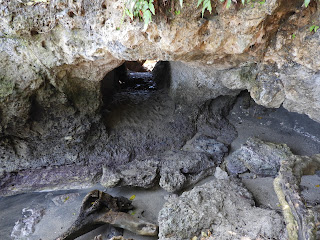As we sailed toward Rabaul, the ship visited the island of Garove,
sailing into its huge caldera. We were
in deep water and the cliffs of the caldera towered hundreds of metres above
us. When the captain sounded the horn,
it reverberated around and around the large caldera.
Sailing
into the caldera.
Some of the local
people came out to look.
Arriving in Rabaul, we were indeed sailing into another
caldera. The old city was decimated by
volcanic eruptions in 1994 but has been rebuilt further from the volcano. The blast that created the enormous caldera
where the port is located occurred about 1,500 years ago.
We had arrived on Independence Day and were greeted by a
local choir rather than the nubile dancers from our last two stops.
We were soon ashore and found a local tour to take us
sightseeing. Our first stop was the
Japanese submarine base out along a dusty, rutted road. We clambered around the rocks to see the
supply tunnels. The water drops down
immediately to a depth of 300 metres where the submarines hid.
At the
Japanese submarine base.
We drove to a viewpoint where we could see out over the
caldera with our ship dominating the port.
Close by is the seismic monitoring station where we talked to the vulcanologist
and examined the monitoring equipment..
The Rabaul
caldera.
Our next stop was Admiral Yamamoto’s bunker where we
climbed through the tunnels until we could not see anything in front of
us. We toured the nearby museum housed
in the New Guinea Club with its collection of war memorabilia.
The market
amongst the war machines!
We drove through the ruined old town of Rabaul out to the
former airport. There is no sign left of
any infrastructure at the airport and the whole of Chinatown has disappeared
under the ash. Some derelict buildings
remain in the town, many just a shell.
Hard to believe that only 5 people died!
We were
close to the volcano that rises above the old town.
At the nearby hot springs in water temperature of 96
degrees Celsius, it was too hot for a dip but they were cooking eggs! The Japanese had built bathhouses in this
area during their occupation.
Gail at the
hot springs.
We sailed out of the caldera past the two active
volcanoes and the ship turned 360 degrees to give everyone a view. By the time we turned to head for the Solomon
Islands, the sun was setting over the caldera.
The two
volcanoes of Rabaul.
Sunset over
the caldera.










1 comment:
Harrison wants to know what the volcanoes are called.
Alex said he wants to see a volcano,
Post a Comment